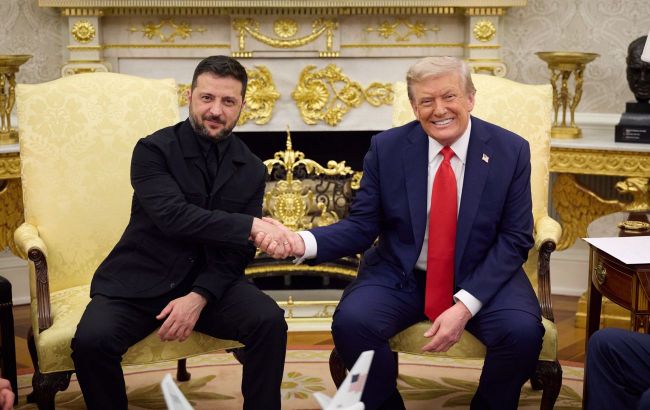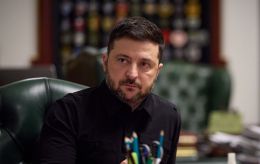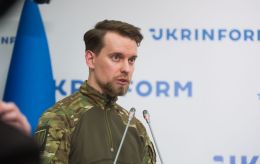Ceasefire or endless war: What Ukraine faces in talks with Russia
 Volodymyr Zelenskyy and Donald Trump at a meeting in the Oval Office (photo: Getty Images)
Volodymyr Zelenskyy and Donald Trump at a meeting in the Oval Office (photo: Getty Images)
Read below about the negotiating positions with which Ukraine enters the fall of 2025, the chances for a ceasefire, and the risks of a prolonged war.
Key questions:
- Why did the US think that achieving a truce by the end of summer was realistic?
- Why could the war of attrition continue next year?
- How does Trump still expect to get a “quick victory” in Ukraine?
Two weeks have passed since Zelenskyy and European leaders visited Washington. In that time, the enthusiasm with which the media described those talks has completely disappeared.
It’s quite obvious that the meeting was no real breakthrough in the peace settlement. While Donald Trump continues to publicly express confidence that everything is going forward, in reality, he is also dissatisfied with the lack of progress, according to US media reports. He is actively trying to find someone to blame.
As often happens with the American President, anyone may be blamed - except the aggressor state itself. Characteristically, over the past two weeks, it was Russia that made maximum efforts to derail any substantive peace process, once again presenting Ukraine with its maximalist demands from 2022 and refusing any compromises.
After the emotional rollercoaster of August (Witkoff’s trip to Moscow, the Alaska summit, talks in Washington), Ukrainians now find themselves in limbo. On the one hand, there is still some real movement - phone calls and meetings between top officials, preparations for security guarantees for Ukraine. On the other hand, the war continues as before, acts of terror take place in the rear, and Russian forces prepare new offensives. It seems that a peace settlement is just as distant as six months or a year ago.
After speaking with various sources in political and diplomatic circles, RBC-Ukraine outlined two approximate scenarios for how events could develop.
Scenario 1: War continues in 2026
“I think we managed this tough moment fairly well. At the very least, we stirred up those sweet sleeping European dwarves, they’ll now help us more actively, and Trump got an earful about Orban, among other things,” a source from Zelenskyy’s inner circle told RBC-Ukraine.
His main forecast comes down to this: the war will continue for the foreseeable future, at least the next few months, and will confidently roll into 2026.
The point is, Trump apparently has no intention of returning to the idea of tough sanctions against Russia - sanctions that were supposed to be launched in mid-August but which Putin once again managed to avoid.
 Steve Witkoff and Vladimir Putin in the Kremlin (photo: Getty Images)
Steve Witkoff and Vladimir Putin in the Kremlin (photo: Getty Images)
Despite all efforts by Ukraine and its European allies, they have not managed to get a simple message across to Trump - that Putin is simply stringing him along. Moreover, lately, Trump has increasingly emphasized the responsibility of both sides, Ukraine and Russia, for what is happening.
Even the latest shelling of Kyiv seemed to leave no impression on the US President, although this was exactly the effect European leaders were hoping for. In the early hours of Thursday, a fairly coherent theory was shattered: that as long as all sides played Trump’s game and pretended interest in peace talks, there would be no airstrikes on Kyiv - so as not to anger the US leader. As it turned out, the fate of the Ukrainian capital, about which Trump loves to muse, doesn’t concern him nearly as much as many wanted to believe.
According to one RBC-Ukraine source, Washington really did hope that Trump’s current round of efforts would bring results in the form of a truce or even a peace deal by the end of August.
Especially since Moscow seemed to have decided what it could “sell” to its own population as a victory - the capture of the entire Donbas. The narrative goes: since “everything started” from these two regions, their complete occupation would supposedly close the circle of history.
But the Americans made a key mistake in their calculations: they assumed that Ukraine would agree to give up Donbas. “They saw some polls suggesting people don’t really care about Donbas. But ‘don’t care about Donbas’ and ‘we’ll surrender Donbas’ are two completely different things - something the Americans failed to grasp,” the source explained. From the very first moment when “territorial swaps” were raised, Ukraine made it crystal clear it would not surrender land without a fight.
Without resolving the territorial issue, there is no real progress to be made in negotiations. Trying to substitute it with other topics, like security guarantees, won’t work.
Two weeks after the Washington summit, it looks like any “progress” in negotiations exists only in Trump’s imagination. At the very least, Russia’s statements and actions over this period made it clear that Moscow is unwilling to make any serious concessions. Most likely, Witkoff and Trump simply misunderstood Putin. After all, Russian propaganda has once again repeated its moldy story about the “illegitimate Zelensky.”
Still, everyone continues playing along with Trump’s rules. Even Russia hasn’t dared to openly declare that it will never meet with Zelenskyy under any circumstances. Likely, that would be crossing a red line even for Trump.
“Trump will now demonstratively stand ‘above the fray.’ The US is already effectively in pre-election mode for Congress (the elections will be held in November 2026 - ed.), and his electorate is split almost in half: half in favor of helping Ukraine, half against involvement in ‘foreign wars.’ So he will balance,” the source in Zelensky’s circle said.
 Aftermath of the latest shelling of Kyiv (photo: Vitalii Nosach / RBC-Ukraine)
Aftermath of the latest shelling of Kyiv (photo: Vitalii Nosach / RBC-Ukraine)
Under this scenario, Ukraine faces long months of war of attrition. The core question remains the same as before: who “runs out” first - Ukraine or Russia?
Currently, Kyiv has the advantage of more active European allies, and US arms purchases under the PURL (Prioritised Ukraine Requirements List) program appear to be running smoothly. On the other hand, Russia has the backing of giant China, and Washington’s levers of influence on Beijing are limited, since they boomerang back against the American economy itself.
According to one version heard by RBC-Ukraine, the key to ending the war may lie not in Washington, Kyiv, or even Moscow, but in Beijing. And for now, it seems China is “allowing” Moscow to keep fighting, as long as the Kremlin doesn’t cross Beijing’s own red lines - for example, a direct attack on NATO countries.
Scenario 2: Trilateral meeting and ceasefire
There is another possible scenario, described by informed sources in conversations with RBC-Ukraine. They agree that further peace settlement depends on leader-level negotiations - whether bilateral, trilateral, or whether they will happen at all. Initially, Ukrainian officials expected such a meeting by the end of August, now, hopes are for September.
“Time is not on our side. Now we want to hold such a meeting by the end of September,” one source explained.
According to RBC-Ukraine, some in Ukraine’s military-political leadership insist that the talks should be strictly trilateral, with Trump’s participation being mandatory.
The main achievement of such talks should be a ceasefire, RBC-Ukraine’s sources explain. Moreover, in a trilateral format, Trump and Zelenskyy could jointly pressure Putin into agreeing.
“A meeting between just Zelensky and Putin will lead nowhere, only set everything back. It’ll end with them simply fighting,” one source said.
According to RBC-Ukraine, Ukrainian officials discussed the need for a trilateral meeting with US Presidential Envoy Keith Kellogg in late August, when he visited Kyiv. According to one source, he approved the idea. What’s more, according to interlocutors, Russians signaled through their channels that they too supported a trilateral format.
 Zelenskyy and European leaders at the White House (photo: Getty Images)
Zelenskyy and European leaders at the White House (photo: Getty Images)
The Ukrainian side hopes Kellogg will now pass this idea to Trump. At the same time, Trump, having leverage over Putin, could push him to agree to such a meeting soon.
The logic here is that the US President is interested in results - in stopping active hostilities as quickly as possible. Achieving a ceasefire between Ukraine and Russia is far simpler and faster than working out a comprehensive peace deal acceptable to both sides. And this could be the very “quick victory” Trump hopes to present to his audience.
“Trump may push Putin toward such an option. Whether he sells it as an end to the war or as a comprehensive peace deal will be secondary. Right now, he’s dreaming of the Nobel Peace Prize. He’ll come out and say: ‘I stopped the war, people aren’t dying, let them keep discussing the details,’” one source noted.
Further steps after a ceasefire could include monitoring along the front line, perhaps creating a demilitarized zone, prisoner exchanges, security guarantees, and launching talks about a peace deal.
“During the Washington negotiations with European leaders, we discussed disengagement of forces - creating a demilitarized zone. We proposed 30 kilometers - 15 km on each side. The Europeans proposed 40 kilometers - 20 km each,” one source noted.
This so-called buffer zone, according to one of the plans now discussed by European officials and diplomats, would be patrolled by peacekeepers. However, many in Ukraine’s government are skeptical of this idea.
“More realistic and effective guarantees of security for Ukraine after a ceasefire would be continued arms supplies to sustain the Armed Forces, and economic guarantees - EU funding for rebuilding the country,” one source said.
There is also a possibility that after a ceasefire, Ukraine and Russia may never reach a peace deal. Some RBC-Ukraine sources openly raise this scenario. In that case, the “peace settlement” would effectively become a frozen conflict.
“If we enter a peace-talks mode - that’s years. This frozen conflict option, though not the most stable, may be better for Ukraine than the suicidal surrender of the territories Russia hasn’t yet captured. True, in such a case, some sanctions on Russia may be lifted, but hardly all at once - the US itself isn’t interested in that,” one source reasoned.
Another possible variant is that Trump manages to broker with Putin and Zelenskyy some general terms of a peace deal acceptable to both sides. A political source suggested that the US President could “push” the Kremlin into a peace deal along the current front line - without demanding all of the Donetsk, Zaporizhzhia, and Kherson regions.
“Then, after a ceasefire, all terms of the peace deal could be formalized within a limited timeframe. Trump has the tools to make it happen,” the source said.
But this scenario also has a downside. If Trump’s priority is stopping the war, does it matter to him at whose expense? Just as the US can pressure Moscow into a deal, it can also pressure Ukraine and its European partners.
“Trump’s logic could go the other way: if one side won’t accept the terms, pressure the other. But the truth is, Trump is less inclined to pressure Moscow, because he sees more prospects in economic ties with Russia than with Ukraine,” one source suggested.
 Donald Trump and Vladimir Putin in Alaska (photo: Getty Images)
Donald Trump and Vladimir Putin in Alaska (photo: Getty Images)
What is common across all versions of this scenario is that it is unlikely to bring Ukraine a durable peace for decades. Many RBC-Ukraine sources believe that even after a peace deal, or without one, Russia will still strive to launch new aggression to conquer Ukraine. The only safeguard against this prospect may be postwar unity of Ukrainian society, strengthening of the army and defense industry, and remembrance of the lessons of this war.
Therefore, while this second scenario may look more optimistic than a prolonged war of attrition, it still doesn’t guarantee Ukraine a peaceful life. For that, the real “root cause of the conflict” - Russia with its imperial ambitions - would have to be eliminated.

